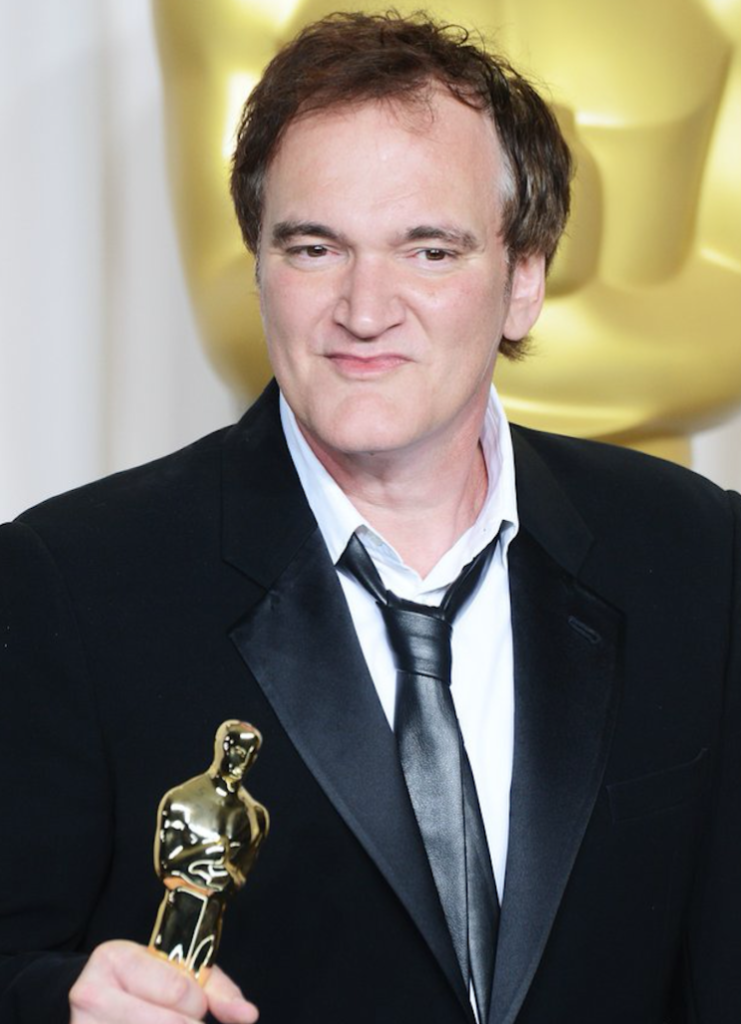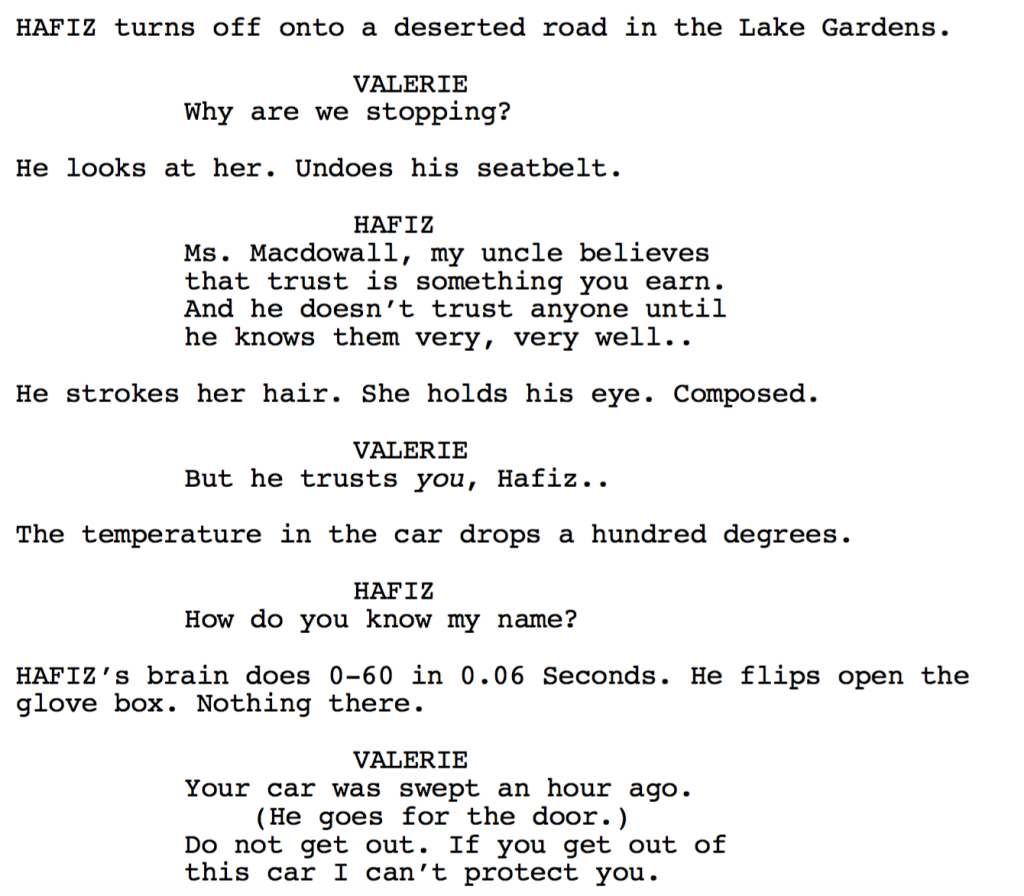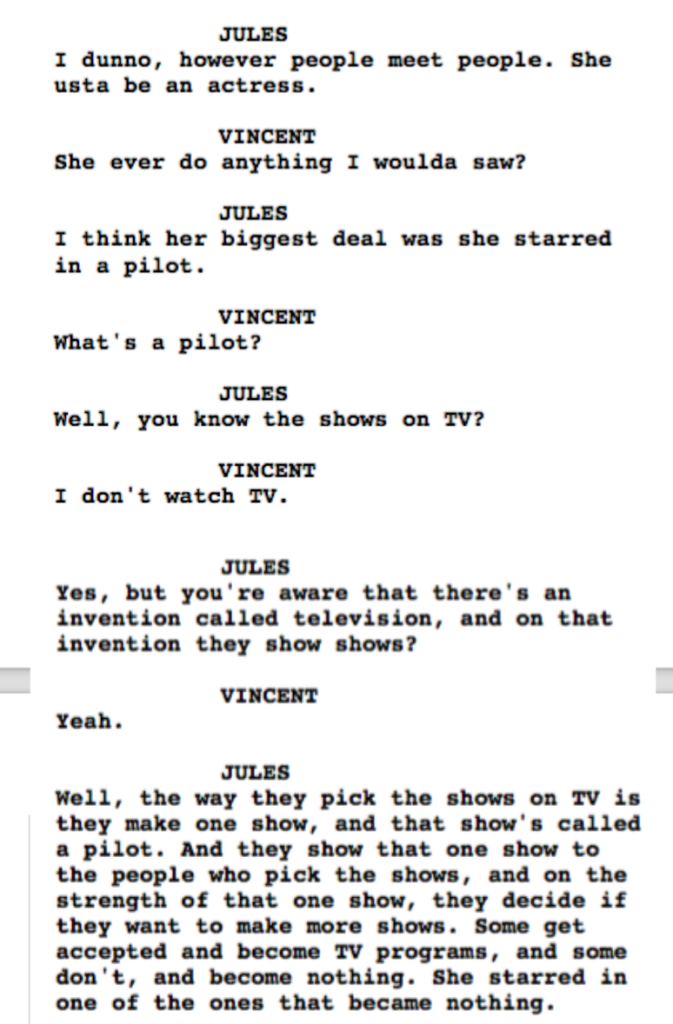I’m not going to lie. I wasn’t thrilled with the results from last week’s dialogue challenge. Nobody blew me away with any world-changing dialogue. It seemed like some people weren’t even paying attention to the dialogue. They had an idea for a short and dialogue happened to be a part of it. I take responsibility for this. Obviously, something I’m saying isn’t getting through.
So I want a do-over. I think you guys are capable of much better. And we’re going to be learning from the master today so I’m hoping that’ll inspire you. But before we start, there was one issue from last week I want to eliminate immediately…
TOO MUCH DESCRIPTION
When dialogue is being featured, you don’t want anything mucking it up. And nothing mucks up dialogue faster than a bunch of description. You want the reader’s eyes on the center of the page. You don’t want them to keep looking left to read some superfluous action. It KILLS the rhythm of the scene. And rhythm is one of the keys to great dialogue. So please: KEEP DESCRIPTION TO A MINIMUM WHEN FEATURING DIALOGUE.
Now, on to today’s three dialogue tips, inspired by Quentin Tarantino.
IRONY
Like most things in screenwriting, dialogue improves with irony. You achieve this by having your characters speak in a manner that’s the opposite of who they are. A famous example of this is Jules and Vincent in Tarantino’s Pulp Fiction. They’re the chatty hitmen. They’re talking about burgers, footrubs, TV pilots. Hitmen aren’t supposed to be fun and chatty. So it’s ironic. And audiences eat irony up. Nuns talking about fucking. Clowns talking about suicide. Kids talking about 401ks. Use irony to write better dialogue.
LOOMING SENSE OF DREAD (SUSPENSE)
Set up a scenario by which something bad (or potentially bad) is coming, draw the resolution out as long as possible, and have fun with the dialogue in the meantime. The space between the beginning and end of a line of suspense is one of the easiest places to write dialogue because your audience is so dialed in. This allows you to have fun with your dialogue as well as the particular conflict within that scene. The best example of this in Tarantino’s world is the beginning of Inglorious Basterds. Hans the Nazi comes into a farm house looking for Jews (who happen to be hiding underneath the floor). Tarantino has so much fun as we wonder if Hans is going to find what he’s looking for. Also note that Hans is a chatty polite Nazi (irony!).
SEXUAL TENSION WITH AN OBSTACLE IN THE WAY
An easy way to bump up your dialogue is to put two characters with heavy sexual chemistry together, then place an obstacle in the way of them being able to act on that attraction. The bigger the obstacle, the better the dialogue will play out. Tarantino’s most famous scene ever is built around this conceit: Vincent Vega and Mia Wallace going out for dinner. Vincent is doing this as a favor to his boss, who’s married to Mia. So the obstacle between them is as big as it gets. If Vincent does anything with Mia, he will be killed (as Tarantino cleverly set up in the earlier scene between Vincent and Jules). This is why the sexual chemistry (and subsequent dialogue) crackles so much. Because they fucking want each other but cannot talk about or act on it. This creates subtext, which adds a whole other layer underneath the already fun dialogue that’s happening on the surface. An easy way to write great dialogue.
BONUS TIP: DIALOGUE OBSTACLES
I’ve already told you guys to place obstacles in front of your hero’s goal. So if Daniel is trying to defeat Johnny in the karate tournament, you give him a broken leg (obstacle) to make achieving his goal even harder. What I’ve noticed about Tarantino is he places obstacles in his dialogue. So it’s rarely as simple as, “Are you okay today?” “Yeah, how bout you?” “Tough day at work.” “Hey, one day at a time, right?” Instead, when someone says something, he’ll have the other character challenge it, or say he doesn’t know what he’s talking about. This is the “obstacle” that forces the first character to re-route or explain things further. What this does is it gives the dialogue more of an unpredictable pattern, and adds a playfullness to it. Here’s an example:
Notice how he says, “I don’t watch TV.” That dialogue obstacle leads to the best line in the exchange, “Yes, but you’re aware that there’s an invention called televsion, and on that invention they show shows?” That line is nowhere to be found without a dialogue obstacle.
And there you have it. If you look at Tarantino’s less memorable scenes, they’re usually scenes that aren’t utilizing these tips. For example, the Butch and Fabienne motel room scene in Pulp Fiction talking about pancakes has some fun exchanges, but it’s way slower than a typical Tarantino scene because it isn’t using any of these devices.
So tomorrow, that’s what this weekend’s short contest will require. You’ll have to use two of these four devices. And also, remember to have fun with your dialogue. Stay away from the mundane and the obvious. Memorable dialogue requires characters to say things in colorful, unexpected, and unpredictable ways. I didn’t see enough of that last week. Hopefully, that will change tomorrow!
AND DON’T FORGET TO SIGN UP FOR THE OFFICIAL SCRIPTSHADOW SHORT SCRIPT CONTEST! IT’S FREE AND THE WINNER GETS THEIR SHORT PRODUCED!!!




